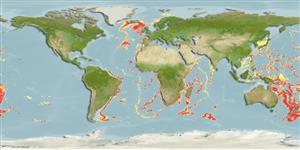Environment: milieu / climate zone / depth range / distribution range
Ökologie
seewasser bathydemersal; tiefenbereich 385 - 2200 m (Ref. 54804). Deep-water
Worldwide in tropical, subtropical and temperate waters (Ref. 33390).
Size / Gewicht / Alter
Maturity: Lm ? range ? - ? cm
Max length : 100.0 cm TL Männchen/unbestimmt; (Ref. 4454)
Kurzbeschreibung
Bestimmungsschlüssel | Morphologie | Morphometrie
Greyish black in color, darker on snout, throat and belly (Ref. 6591).
Inhabits the lower continental slope (Ref. 4454).
Life cycle and mating behavior
Geschlechtsreife | Fortpflanzung | Ablaichen | Eier | Fecundity | Larven
Smith, D.G., 1990. Nettastomatidae. p. 172-175. In J.C. Quero, J.C. Hureau, C. Karrer, A. Post and L. Saldanha (eds.) Check-list of the fishes of the eastern tropical Atlantic (CLOFETA). JNICT, Lisbon; SEI; Paris; and UNESCO, Paris. Vol. 1. (Ref. 4454)
IUCN Rote Liste Status (Ref. 130435: Version 2024-1)
Bedrohung für Menschen
Harmless
Nutzung durch Menschen
Fischereien: nicht kommerziell
Tools
Zusatzinformationen
Download XML
Internet Quellen
Estimates based on models
Preferred temperature (Ref.
123201): 2.6 - 7.4, mean 5.1 °C (based on 1171 cells).
Phylogenetic diversity index (Ref.
82804): PD
50 = 0.5312 [Uniqueness, from 0.5 = low to 2.0 = high].
Bayesian length-weight: a=0.00063 (0.00029 - 0.00138), b=2.93 (2.74 - 3.12), in cm total length, based on LWR estimates for this species & (Sub)family-body (Ref.
93245).
Trophic level (Ref.
69278): 3.5 ±0.5 se; based on size and trophs of closest relatives
Widerstandsfähigkeit (Ref.
120179): niedrig, Verdopplung der Population dauert 4,5 - 14 Jahre. (Assuming tmax>10).
Fishing Vulnerability (Ref.
59153): High vulnerability (60 of 100).
Nutrients (Ref.
124155): Calcium = 11 [3, 36] mg/100g; Iron = 0.385 [0.129, 0.984] mg/100g; Protein = 17.6 [15.3, 20.0] %; Omega3 = 0.358 [0.147, 0.975] g/100g; Selenium = 21.5 [6.3, 71.1] μg/100g; VitaminA = 5.92 [1.11, 30.33] μg/100g; Zinc = 0.281 [0.145, 0.549] mg/100g (wet weight);
